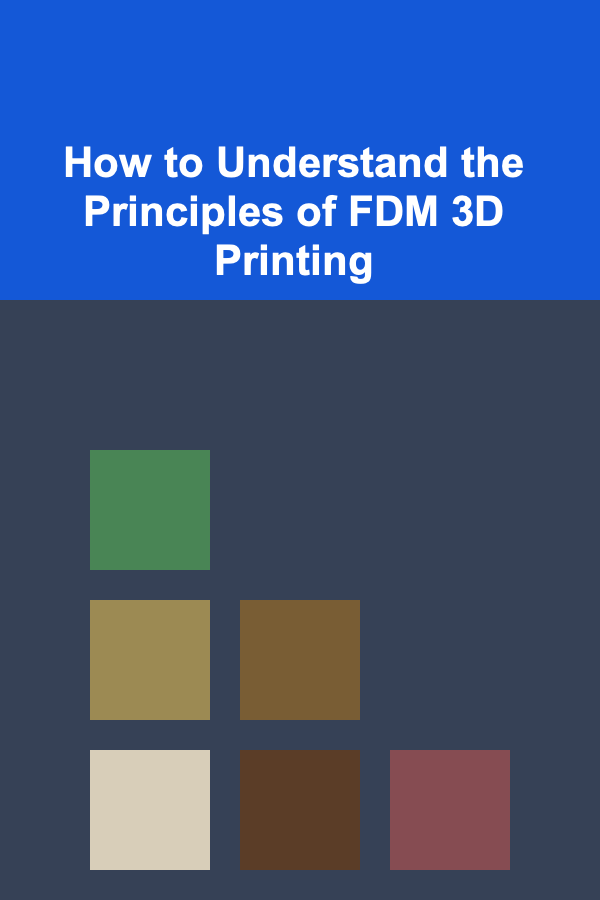
How to Understand the Principles of FDM 3D Printing
ebook include PDF & Audio bundle (Micro Guide)
$12.99$10.99
Limited Time Offer! Order within the next:

Fused Deposition Modeling (FDM) is one of the most widely used technologies in 3D printing. From prototyping to manufacturing, FDM 3D printing offers accessible and cost-effective ways to create physical objects from digital models. The technology has seen significant advancements over the years and is now used in various fields, including aerospace, automotive, medicine, and even education. However, to truly appreciate and leverage the power of FDM, one must understand the core principles behind how it works. This article dives into the mechanics, material science, and practical considerations that define FDM 3D printing.
What is FDM 3D Printing?
FDM 3D printing is an additive manufacturing process that involves the deposition of material layer by layer to build a 3D object. The material, usually in the form of a thermoplastic filament, is heated until it melts and is extruded through a nozzle to form layers of the printed object. Once a layer is complete, the machine cools and hardens the material, before starting the next layer. This process repeats until the object is fully formed.
The process is widely favored for its simplicity, affordability, and versatility, making it one of the go-to choices for both amateur and professional 3D printing applications. The technology is available in many forms, from personal desktop 3D printers to large industrial machines used for manufacturing.
Key Components of an FDM 3D Printer
1. The Extruder
The extruder is the heart of the FDM 3D printing system. It comprises the hot end (where the material is melted) and the cold end (which feeds the filament into the hot end). The extruder pulls the filament from a spool, pushes it through a heated nozzle, and deposits it onto the build platform. The precise control of the extruder ensures that the material is deposited in thin, controlled layers.
2. Heated Print Bed
A heated print bed is essential in preventing warping and ensuring adhesion of the printed object. As the material cools and solidifies, it can contract, which might cause parts to detach from the bed or warp. The heated bed helps maintain a consistent temperature to mitigate this issue, providing a stable foundation for the object.
3. Stepper Motors and Motion System
FDM 3D printers utilize stepper motors to drive the movement of the print bed and extruder along the X, Y, and Z axes. These motors enable precise movement control to ensure that each layer of the object is placed with accuracy. The motion system typically includes rails, belts, and gears, which work together to facilitate this precise movement.
4. Control Electronics
The control board and software allow the 3D printer to function. The control board interprets the G-code, which contains instructions for the printer's movements and operations. This system also communicates with the sensors, motors, and heated bed, ensuring that each aspect of the printing process is in sync.
The FDM Printing Process Step-by-Step
The FDM process begins with a digital 3D model that is sliced into thin cross-sectional layers using slicing software. The software generates G-code, which contains instructions for the 3D printer on how to build the object layer by layer. Once the G-code is ready, the printing process begins, and the following steps take place:
1. Preparing the Print Bed
The printer bed is cleaned and prepped for the print job. Depending on the material being used, the bed may be heated to a specific temperature to help with adhesion. Some users also apply adhesive solutions, such as hairspray or specialized print bed tapes, to further ensure proper adhesion.
2. Melting the Filament
The 3D printer extruder heats up the filament to a temperature just below the melting point of the material. As the filament enters the extruder, it is pushed through the hot end, which melts the filament and prepares it for extrusion.
3. Extrusion and Layer-by-Layer Deposition
The extruder deposits a thin layer of molten filament onto the print bed. The extruder then moves to the next position, laying down another layer of filament on top of the first. This process is repeated, with each layer bonding to the one beneath it as the material cools and solidifies.
4. Cooling and Solidifying the Material
After the filament is deposited, it begins to cool and harden. The cooling rate is essential to the overall success of the print, as it affects the structural integrity and surface finish. Some 3D printers use cooling fans to accelerate the cooling process, especially for finer details.
5. Post-Processing
Once the print is complete, the object is removed from the bed. Depending on the complexity of the print, post-processing might be required. This can include removing support structures, sanding rough edges, or applying surface finishes like paint or resin coatings.
Materials Used in FDM 3D Printing
One of the significant advantages of FDM 3D printing is the variety of materials that can be used, allowing for customization based on the project's requirements. The most common material types include:
1. PLA (Polylactic Acid)
PLA is one of the most commonly used thermoplastics in FDM printing. It is derived from renewable resources, making it an eco-friendly option. PLA is easy to print with, and its low printing temperature reduces the likelihood of warping. It is widely used in prototyping, education, and consumer applications.
2. ABS (Acrylonitrile Butadiene Styrene)
ABS is a more durable material than PLA, with higher heat resistance. However, it requires a heated print bed to minimize warping during the printing process. ABS is frequently used for creating functional parts and prototypes in automotive, electronics, and engineering.
3. PETG (Polyethylene Terephthalate Glycol)
PETG is a strong, durable material with high chemical resistance and excellent layer bonding. It is commonly used in food containers, medical devices, and other applications requiring both strength and transparency.
4. TPU (Thermoplastic Polyurethane)
TPU is a flexible material that can stretch without breaking, making it ideal for producing parts that need to bend or compress. It is often used in manufacturing phone cases, wearables, and seals.
5. Nylon
Nylon is another versatile and durable material often used for producing functional parts. It has good impact resistance, making it suitable for engineering applications such as gears, bearings, and tools.
Other specialized filaments are also available for specific applications, including metal composites, carbon fiber-reinforced filaments, and even food-safe materials.
Understanding the Factors Affecting FDM Printing Quality
Achieving high-quality prints with FDM technology depends on several key factors. These factors include material selection, print settings, and the printer's hardware quality. Here are some of the most important considerations:
1. Layer Height
The layer height (or resolution) refers to the thickness of each individual layer of material deposited by the printer. A lower layer height results in a smoother, more detailed print but will take longer to complete. A higher layer height reduces print time but can result in a rougher surface finish.
2. Print Speed
The print speed refers to how quickly the extruder moves during the printing process. While printing at faster speeds can save time, it may also reduce print quality due to less precise material deposition. Slower print speeds are typically used to improve the final result, especially for complex geometries.
3. Temperature
The temperature of the hot end and print bed significantly affects print quality. A higher extruder temperature is typically needed for materials with higher melting points, while lower temperatures are used for more delicate materials. Similarly, a heated bed ensures better adhesion and reduces warping.
4. Cooling Rate
Cooling fans are used to speed up the solidification of the material after each layer is deposited. If the material cools too quickly, it may lead to warping or cracking. Cooling fans are especially useful for materials like PLA, which benefit from rapid cooling.
5. Support Structures
Complex prints often require support structures to ensure overhangs or intricate designs are printed successfully. These supports can be removed after the print, but their presence may affect the overall finish of the print if not carefully designed.
6. Calibration
Proper calibration of the printer's axes and extrusion system is crucial for achieving high-quality prints. Misalignment or incorrect extrusion can lead to issues like under-extrusion, stringing, and uneven layers.
Challenges and Limitations of FDM 3D Printing
While FDM 3D printing is an excellent technology, it does have its limitations and challenges:
1. Surface Finish
FDM prints often suffer from visible layer lines and rough surfaces, particularly when printing at higher speeds or with thicker layers. Post-processing techniques such as sanding, polishing, and painting are typically required to improve the aesthetic appearance of the printed object.
2. Material Limitations
While a wide range of materials can be used in FDM printing, the strength and durability of printed objects are often inferior to parts produced through other manufacturing processes, such as injection molding or CNC machining. Additionally, FDM parts are typically anisotropic, meaning they are weaker along the layer lines.
3. Print Time
FDM printing can be a slow process, especially when creating large or highly detailed objects. Print times can vary based on factors like layer height, print speed, and the complexity of the model.
4. Warping and Adhesion Issues
Warping occurs when the printed object contracts unevenly as it cools, causing it to lift off the print bed or distort. To combat this, a heated bed, proper calibration, and the use of adhesives can help improve adhesion and reduce warping.
Conclusion
FDM 3D printing is an accessible and versatile technology that has revolutionized the way we approach manufacturing, prototyping, and personal fabrication. By understanding the key principles, components, and considerations involved in the process, users can unlock the full potential of this technology. From material selection to print settings, every aspect of the FDM process plays a role in determining the quality of the final product. As the technology continues to evolve, so too does its potential for transforming industries and creating new opportunities for innovation.

How to Maintain a Clean Home in a Small Apartment
Read More
How to Maintain an Organized Wardrobe Year-Round
Read More
How to Manage Debt While Balancing Household Finances
Read More
How to Plan Your Budget for Seasonal Expenses
Read More
Passive Income from Deep Learning: The Best Strategies
Read More
How to Budget for a Major Purchase
Read MoreOther Products

How to Maintain a Clean Home in a Small Apartment
Read More
How to Maintain an Organized Wardrobe Year-Round
Read More
How to Manage Debt While Balancing Household Finances
Read More
How to Plan Your Budget for Seasonal Expenses
Read More
Passive Income from Deep Learning: The Best Strategies
Read More